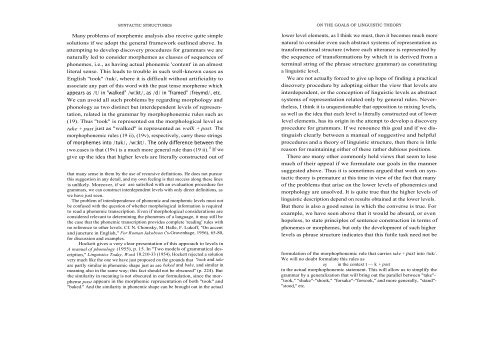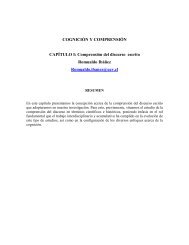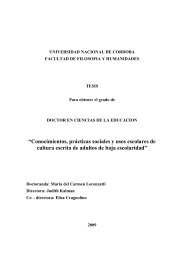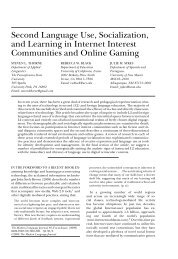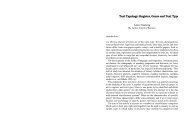Syntactic Structures
Syntactic Structures
Syntactic Structures
Create successful ePaper yourself
Turn your PDF publications into a flip-book with our unique Google optimized e-Paper software.
SYNTACTIC STRUCTURES<br />
Many problems of morphemic analysis also receive quite simple<br />
solutions if we adopt the general framework outlined above. In<br />
attempting to develop discovery procedures for grammars we are<br />
naturally led to consider morphemes as classes of sequences of<br />
phonemes, i.e., as having actual phonemic 'content' in an almost<br />
literal sense. This leads to trouble in such well-known cases as<br />
English "took" /tuk/, where it is difficult without artificiality to<br />
associate any part of this word with the past tense morpheme which<br />
appears as /t/ in "walked" /wɔkt/, as /d/ in "framed" /freymd/, etc.<br />
We can avoid all such problems by regarding morphology and<br />
phonology as two distinct but interdependent levels of representation,<br />
related in the grammar by morphophonemic rules such as<br />
(19). Thus "took" is represented on the morphological level as<br />
take + past just as "walked" is represented as walk + past. The<br />
morphophonemic rules (19 ii), (19v), respectively, carry these strings<br />
of morphemes into /tuk/, /wɔkt/. The only difference between the<br />
two.cases is that (19v) is a much more general rule than (19 ii). 8 If we<br />
give up the idea that higher levels are literally constructed out of<br />
that many sense in them by the use of recursive definitions. He does not pursue<br />
this suggestion in any detail, and my own feeling is that success along these lines<br />
is unlikely. Moreover, if we are satisfied with an evaluation procedure for<br />
grammars, we can construct interdependent levels with only direct definitions, as<br />
we have just seen.<br />
The problem of interdependence of phonemic and morphemic levels must not<br />
be confused with the question of whether morphological information is required<br />
to read a phonemic transcription. Even if morphological considerations are<br />
considered relevant to determining the phonemes of a language, it may still be<br />
the case that the phonemic transcription provides complete 'reading' rules with<br />
no reference to other levels. Cf. N. Chomsky, M. Halle, F. Lukoff, "On accent<br />
and juncture in English," For Roman Jakobson ('s-Gravenhage, 1956), 65-80,<br />
for discussion and examples.<br />
Hockett gives a very clear presentation of this approach to levels in<br />
A manual of phonology (1955), p. 15. In "Two models of grammatical description,"<br />
Linguistics Today, Word 10.210-33 (1954), Hockett rejected a solution<br />
very much like the one we have just proposed on the grounds that "took and take<br />
are partly similar in phonemic shape just as are baked and bake, and similar in<br />
meaning also in the same way; this fact should not be obscured" (p. 224). But<br />
the similarity in meaning is not obscured in our formulation, since the morpheme<br />
past appears in the morphemic representation of both "took" and<br />
"baked." And the similarity in phonemic shape can be brought out in the actual<br />
ON THE GOALS OF LINGUISTIC THEORY<br />
lower level elements, as I think we must, then it becomes much more<br />
natural to consider even such abstract systems of representation as<br />
transformational structure (where each utterance is represented by<br />
the sequence of transformations by which it is derived from a<br />
terminal string of the phrase structure grammar) as constituting<br />
a linguistic level.<br />
We are not actually forced to give up hope of finding a practical<br />
discovery procedure by adopting either the view that levels are<br />
interdependent, or the conception of linguistic levels as abstract<br />
systems of representation related only by general rules. Nevertheless,<br />
I think it is unquestionable that opposition to mixing levels,<br />
as well as the idea that each level is literally constructed out of lower<br />
level elements, has its origin in the attempt to develop a discovery<br />
procedure for grammars. If we renounce this goal and if we distinguish<br />
clearly between a manual of suggestive and helpful<br />
procedures and a theory of linguistic structure, then there is little<br />
reason for maintaining either of these rather dubious positions.<br />
There are many other commonly held views that seem to lose<br />
much of their appeal if we formulate our goals in the manner<br />
suggested above. Thus it is sometimes argued that work on syntactic<br />
theory is premature at this time in view of the fact that many<br />
of the problems that arise on the lower levels of phonemics and<br />
morphology are unsolved. It is quite true that the higher levels of<br />
linguistic description depend on results obtained at the lower levels.<br />
But there is also a good sense in which the converse is true. For<br />
example, we have seen above that it would be absurd, or even<br />
hopeless, to state principles of sentence construction in terms of<br />
phonemes or morphemes, but only the development of such higher<br />
levels as phrase structure indicates that this futile task need not be<br />
formulation of the morphophonemic rule that carries take + past into /tuk/.<br />
We will no doubt formulate this rules as<br />
ey in the context t — k + past<br />
in the actual morphophonemic statement. This will allow us to simplify the<br />
grammar by a generalization that will bring out the parallel between "take"-<br />
"took," "shake"-"shook," "forsake"-"forsook," and more generally, "stand"-<br />
"stood," etc.


